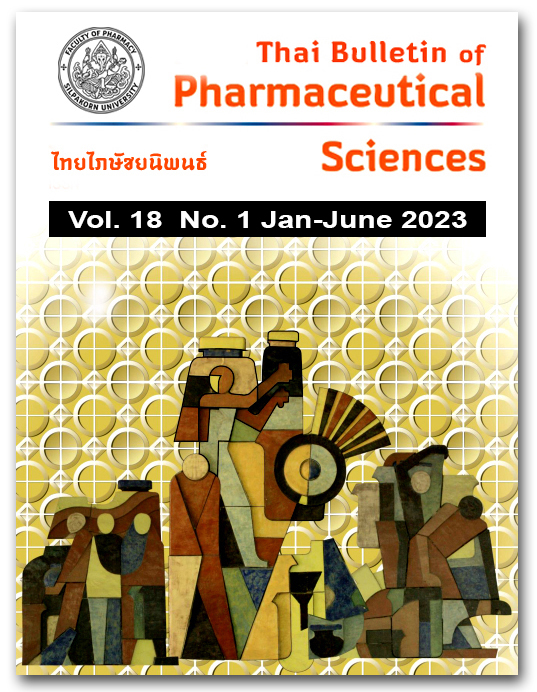ผลการติดตามระดับยา Tacrolimus ในผู้ป่วยปลูกถ่ายตับชาวไทย
DOI:
https://doi.org/10.69598/tbps.18.1.57-69คำสำคัญ:
การติดตามระดับยาในเลือด, tacrolimus, ผู้ป่วย, ปลูกถ่ายตับ, ไทยบทคัดย่อ
Tacrolimus เป็นยากดภูมิคุ้มกันที่มีประสิทธิภาพสูงที่ใช้ป้องกันการปฏิเสธตับในผู้ป่วยปลูกถ่ายตับ แต่เนื่องจากยามีดัชนีการรักษาแคบและมีความผันแปรทางเภสัชจลนศาสตร์สูง จึงมีความจำเป็นต้องติดตามระดับยา tacrolimus ในเลือดเพื่อให้ผู้ป่วยปลูกถ่ายตับได้รับขนาดยาที่เหมาะสม รวมทั้งมีระดับยาในเลือดอยู่ในช่วงการรักษาเป้าหมาย การศึกษานี้มีวัตถุประสงค์เพื่อรายงานแบบแผนการใช้ยา และรายงานผลการติดตามระดับยา tacrolimus ในเลือดของผู้ป่วยปลูกถ่ายตับชาวไทยในช่วง 6 เดือนภายหลังการปลูกถ่ายตับ เพื่อนำผลการศึกษามาพัฒนาระบบการบริบาลทางเภสัชกรรมและวิธีการติดตามระดับยา tacrolimus ให้ดียิ่งขึ้น การศึกษานี้เป็นการวิจัยเชิงพรรณนาชนิดย้อนหลังในผู้ป่วยปลูกถ่ายตับที่รับการรักษา ณ โรงพยาบาลรามาธิบดี โดยเก็บรวบรวมข้อมูลจากเวชระเบียนย้อนหลังเป็นระยะเวลา 12 ปี 3 เดือน จากการศึกษาพบว่าแบบแผนการใช้ยากดภูมิคุ้มกันในผู้ป่วยปลูกถ่ายตับหลักประกอบด้วย immediate-release tacrolimus ร่วมกับ mycophenolate mofetil และ prednisolone โดยผู้ป่วยจะได้รับยา tacrolimus ครั้งแรกภายหลังการปลูกถ่ายตับวันที่ 2 ด้วยขนาดยา tacrolimus เริ่มต้นเฉลี่ย 3.16 มิลลิกรัมต่อวัน (0.05 มิลลิกรัมต่อกิโลกรัมต่อวัน) จากนั้นแพทย์จะพิจารณาขนาดยา tacrolimus ให้เหมาะสมกับผู้ป่วยแต่ละรายจากระดับยา tacrolimus ต่ำสุดในเลื อดและปรับขนาดยา tacrolimus เพื่อให้ระดับยาในเลือดอยู่ในช่วงเป้าหมาย การศึกษานี้ติดตามระดับยา tacrolimus ต่ำสุดในเลือดจำนวน 2,298 ครั้ง จากผู้ป่วยปลูกถ่ายตับจำนวน 61 ราย โดยพบว่าระดับยา tacrolimus ต่ำสุดในเลือดอยู่ในช่วงการรักษาเป้าหมายร้อยละ 14.32 – 24.82 ในระยะเวลา 6 เดือนภายหลังการปลูกถ่ายตับ ในช่วง 7 วันภายหลังการปลูกถ่ายตับ ระดับยา tacrolimus ต่ำสุดในเลือดจะมีค่าสัมประสิทธิ์ของความผันแปรสูงที่สุด (Coefficient of variation เท่ากับ 56.79%) และค่าสัมประสิทธิ์ของความผันแปรดังกล่าวจะลดลงภายหลังการปลูกถ่ายตับไปแล้ว 3 เดือน การติดตามระดับยา tacrolimus ในเลือดของผู้ป่วยปลูกถ่ายตับจึงมีความสำคัญซึ่งจะช่วยลดความเสี่ยงในการเกิดภาะปฏิเสธตับในช่วง 6 เดือนภายหลังการปลูกถ่ายตับซึ่งเป็นช่วงที่ผู้ป่วยปลูกถ่ายตับอาจมีอาการทางคลินิกไม่คงที่ และระดับยา tacrolimus มีความผันแปรทางเภสัชจลนศาสตร์สูง
เอกสารอ้างอิง
Nivatvongs S, Sirichindakul B, Nontasuti B, Kongkam P, Rerknimitr R, Kullavanijaya P. Result of orthotopic liver transplantation at King Chulalongkorn Memorial Hospital: the first series from Thailand. J Med Assoc Thai. 2003;86 Suppl 2:S445-50
Thai Transplantation Society. Thai transplant annual report 2020 [Internet]. Bangkok: The Society; 2020 [cited 2022 July 1]. Available from: https://www.transplantthai.org/data/ annual_report/ 1/2020%20TH.pdf (in Thai)
McAlister VC, Haddad E, Renouf E, Malthaner RA, Kjaer MS, Gluud LL. Cyclosporin versus tacrolimus as primary immunosuppressant after liver transplantation: a meta-analysis. Am J Transplant. 2006;6(7):1578-85.
Lemaitre F, Tron C, Renard T, Jézéquel C, Houssel-Debry P, Bergeat D, et al. Redefining therapeutic drug monitoring of tacrolimus in patients undergoing liver transplantation: a target trough concentration of 4-7 ng/mL during the first month after liver transplantation is safe and improves graft and renal function. Ther Drug Monit. 2020;42(5):671-8.
EASL Clinical practice guidelines: liver transplantation. J Hepatol. 2016;64(2):433-85.
Thai Transplantation Society. Thai transplant care (TTC) liver [Internet]. Bangkok: The Society; 2015 [cited 2022 July 1]. Available from: http://www.transplantthai.org/ upload/170815114538293_MNB.pdf (in Thai)
Zhang Y YJ, Zhu LQ and Wang N. Effects on pharmacokinetics of tacrolimus in liver transplant patients. SM J Pharmac Ther. 2016;2(1):1012.
Tharanon V, Sobhonslidsuk A, Intaraprasong P, Sra-ium S, Sakulchairungrueng B, Gesprasert G, et al. Population pharmacokinetics of tacrolimus in Thai liver transplant patients. Thai Bull Pharm Sci. 2021; 16(1):17-30.
Varghese J, Reddy MS, Venugopal K, Perumalla R, Narasimhan G, Arikichenin O, et al. Tacrolimus-related adverse effects in liver transplant recipients: its association with trough concentrations. Indian J Gastroenterol. 2014;33(3):219-25.
Touw DJ, Neef C, Thomson AH, Vinks AA. Cost-effectiveness of therapeutic drug monitoring: a systematic review. Ther Drug Monit. 2005;27(1):10-7.
Wallemacq P, Goffinet JS, O'Morchoe S, Rosiere T, Maine GT, Labalette M, et al. Multi-site analytical evaluation of the Abbott ARCHITECT tacrolimus assay. Ther Drug Monit. 2009;31(2):198-204.
Wallemacq P, Armstrong VW, Brunet M, Haufroid V, Holt DW, Johnston A, et al. Opportunities to optimize tacrolimus therapy in solid organ transplantation: report of the European consensus conference. Ther Drug Monit. 2009;31(2):139-52.
Lexi-Drugs/Tacrolimus. Lexicomp app. UpToDate Inc. Accessed October 8, 2022.
Rayar M, Tron C, Jezequel C, Beaurepaire JM, Petitcollin A, Houssel-Debry P, et al. High intrapatient variability of tacrolimus exposure in the early period after liver transplantation is associated with poorer outcomes. Transplantation. 2018;102(3):e108-e14.



